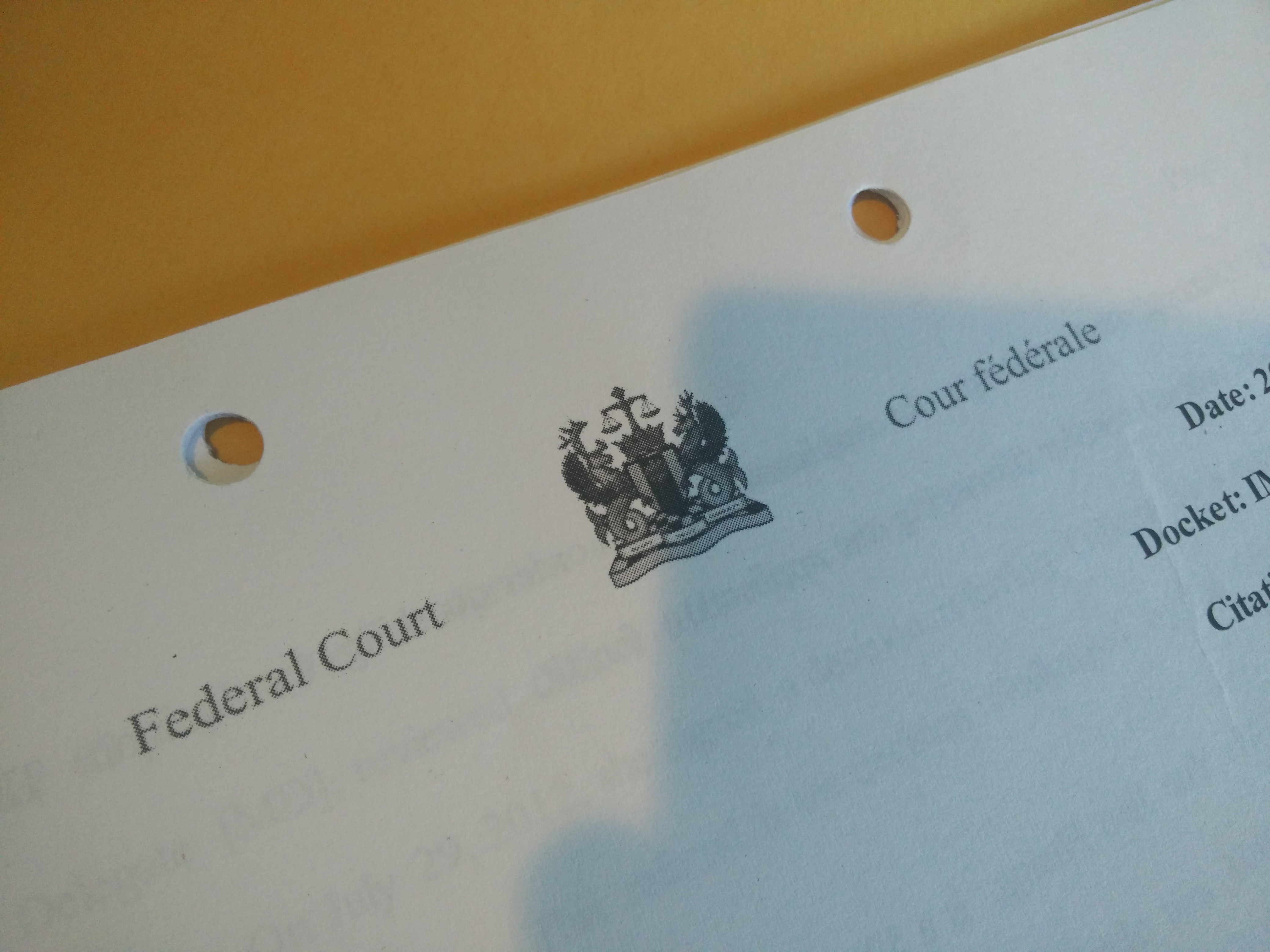Introduction
My mentor and colleague Steve often tells me when I go on and on about having found the “perfect precedent” for my case that in the realm of the Federal Court such a term is not so easily contrived and applied.
The fact specific nature of immigration inquiries combined with the cautious nature of many judgments written by the Bench that emphasis this, make it often difficult to establish precedent. The standards of review (reasonableness and correctness) themselves open up a certain level of discretion. What may be reasonable in one circumstance can become unreasonable in another. What is procedurally fair in one circumstance can be unfair in another.
More often than not using Federal Court case law (in the context of Federal Court) becomes the task of not arguing whether legal principles are right or wrong but taking your client’s case, case law in support, and case law not in support, and sussing out the factual nuances.
Certifying a question, the only way by which the case can go to the Court of Appeal and eventually to the Supreme Court of Canada is becoming more and more difficult. You are more frequently seeing Federal Court judges rule this way: (example taken from Steve’s recent win in Federal Court in Gupta v. Canada (Public Safety and Emergency Preparedness) 2015 FC 1086).
[26] The respondent takes the position that this matter is too fact-specific to merit certification of a serious question of general importance. At the respondent’s suggestion, I will not certify a question.
That being said, there is a recent case of cautious judicial writing but one that makes what amounts to quite a strong criticism of some of the elements of the CIC’s current practice if sending admissibility procedural fairness letters.
For those that are new to the term, procedural fairness letters are the letters CIC sends when there is further information they need or further submission they require you to make in order to dispel them of their concerns. In some application contexts, failure to submit an adequate response will lead to applications being thrown out. In other contexts, such as inadmissibility, the consequences will be more sever as an s.44 inadmissibility report may be written up on your client.
For immigration lawyers/practitioners, it represents the first (and possibly last) opportunity we will have to effectively represent the client before any litigation (i.e. Federal Court and Immigration Appeal Division in some cases) where the onus shifts quite drastically to the Applicant to prove his or her case.
Guerrero v. Canada (Citizenship and Immigration) 2015 FC 1086
The Guerrero case is a very interesting one for the situation is not an uncommon one but the consequences are quite severe. In fact, in our office we have done a few consultations on related situations.
To sum it up briefly (as you can read the entire case: here), Mr. Guerrero applied for permanent residency through the Federal Skilled Worker program in 2010 and added his wife, Merambel, after marriage in 2013. During his interview at the Port of Entry and prior to finalization of the PR application, it came to light that Guerrero had had an affair with a lady named Martinez (a coworker). He made some statements at the Port of Entry during his interview, that formed the basis of Officer’s notes.
Based on CIC’s concern about the relationship, a procedural fairness letter sent referencing misrepresentation and the bona fides of the relationship. In response, Mr. Guerrero sent statutory declarations and provided evidence of his relationship.
Finally a decision was issued, finding that he had misrepresented himself in statements he made at the port of entry as they contradicted with his written statements in response to the procedural fairness letter.
Justice Southcott’s decision in Guerrero turned on an analysis of procedural fairness and whether the failure to provide the Applicant a fair opportunity to contradict or corrective statements amounted to a breach of procedural fairness.
Justice Southcott’s decision, I found, very clearly distinguished between situations where the applicant themselves provides information versus the use of extrinsic information that the applicant is unaware of (para 28 of that decision).
The nuance here is that Justice Southcott found that the officer’s port of entry notes, containing statements purported to have been made by Guerrero and Martinez, was not considered evidence that Mr. Guerrero should have been aware of. Justice Southcott writes (emphasis added):
[31] The challenge for the Respondent in advancing this position is the fact that, prior to production of the Certified Tribunal Record as part of this judicial review application process, the Applicants had never seen, reviewed or approved these notes. The notes are therefore different from a written statement or other documentary evidence submitted by an applicant and different from someone else’s record of what an applicant has said where the applicant was provided an opportunity to review such record. In my view, in the absence of such an opportunity, depending on the use of the record, the duty of procedural fairness may be engaged so that the impugned individual is not deprived of the opportunity to raise concerns about whether the statements were recorded accurately.
Interestingly, Justice Southcott went into an even more nuanced analysis by looking at the specific language of the procedural fairness letter and whether it provided the Applicant with the required opportunity to respond. He concluded that the letter (emphasis added):
“does not set out the detail of the statements, purported to have previously been made by Guerrero and Martinez as reflected in the port of entry notes, on which the Officer’s concerns were based. Guerrero’s affidavit, filed in support of this judicial review application, states that he advised the CBSA officers in November 2013 that his relationship with Martinez came to an end in April 2013 when he married Merambel and that he never stated that he would end the relationship when his wife came to Canada.”
Finally, and again consistent with what I was discussing earlier, Justice Southcott applies judicial caution in explicitly suggesting that this case was fact specific and that he was not suggesting a general requirement for the provision of Officer’s notes (usually obtained by counsel at ATIP but sometimes only received at the CTR stage). He writes (emphasis added):
[40] I am conscious of the Respondent’s point that it is not common practice to provide port of entry notes in circumstances such as these as part of the duty of procedural fairness. I am not suggesting that there should be a general obligation to do so. Rather, my conclusion is that, in the specific circumstances of this case, given the particular use that was made of such notes by the Officer in making the Decision, the content of the procedural fairness letter did not contain sufficient detail to satisfy the duty of fairness. My finding is that the Officer’s approach to the discharge of that duty was accordingly incorrect and, if I were to afford some degree of deference to the manner in which the Officer approached that duty, I would also conclude such approach to be unreasonable.
Why I Hope This Case Gets Emphasized More By Counsel
Even in light of all of Justice Southcott’s cautious reasoning, I think his analysis does raise a very real challenge to the status quo of broad procedural fairness letters.
For example, in one of the recent cases we worked on in this office relating to criminal inadmissibility, we were quite sure the tactic of CBSA was to pass the ball to us first rather than to have them weigh through the thousand pages of evidence. The procedural fairness letter was very broad and did not even specify what criminal code provision our client was being found to have ‘committed’ an equivalent offense under.
While perhaps most relevant in the inadmissibility context, where the consequences on the applicants are very severe, I could see this principle applied to all types of economic and family immigration cases. Many procedural fairness letters that are sent are standard-form, and certainly much less detailed than the ones the Guerrero’s were afforded.
While the practice of counsel ATIPing to get the ‘cards held by CIC/CBSA’ will continue, it does suggest that our immigration officials need to be more thorough in laying out their claims before sending the letters.

